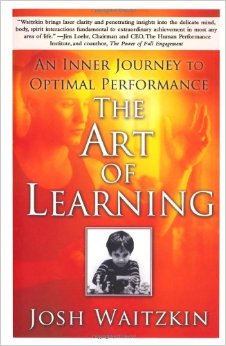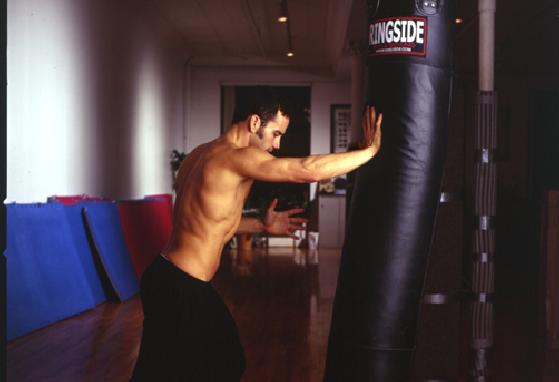
The Art of Learning: An Inner Journey to Optimal Performance
June 09, 2016
“A core part of the way I train people is around the interplay of themes or principles and habits. The habits are what we can actually train…the principles are what we are trying to embody.”
Josh Waitzkin, on The Tim Ferris Show

When I started writing this blog in 2012, I was mostly driven by my desire to create the sort of resource (map) that was lacking when I started trying to find and then learn a functional approach to Wing Chun.
It’s no secret that many people who have trained in various Wing Chun schools discover their “skills” are not up to handling the sort of attacks they encounter from other fighters using other styles. I looked for 8 years (because I’m crazy like that) until I found a teacher whose approach to Wing Chun (if you put in the hard work) was capable of handling any comers.
I always knew it existed and I found it and then I wanted to share what I had learned. I wanted to share the the short-cuts I’d eventually found, and most importantly, the basic ideas. Ideas are ultimately what make the difference. As my Sigung says, “An ox works hard all day, but when night comes, he’s still an ox.” You need the right ideas so you can train smart and not waste your time.
Over the course of writing hundreds of posts, I’ve discovered my “wheelhouse” or place in the Wing Chun community.
My job is to find the best ideas in Wing Chun and the best ideas from outside which can support Wing Chun and present them in a clear and simple fashion. To put it more bluntly, my job is to separate the “shit from the Shinola” and present my findings. Like a museum curator, I sift through the vast amount of information and bring only the jewels to your attention. The real and the true.
The best ideas from outside Wing Chun often come from either other styles (Boxing, BJJ, etc) or the sciences, such as Engineering and Psychology. They often show up inside books, such as The Art of Learning .
One of the most important skills you have to learn in order to go from beginner to intermediate as a fighter (or anything really) is the intelligent self-assessment combined with goal setting.

You have to check yourself, see where you are, and figure out how to take the next few steps. This is what my Sifu calls a “training direction.”
“If even for a blink of an eye you can control two of the other guy’s limbs with one of yours, either with angle or timing or some sort of clinch, then the opponent is in grave danger. The free hand can take him apart.”
Josh Waitzkin
Waitzkin’s book is a chronicle of how he learned to learn. This is a key concept and deserves emphasis.
The most valuable skill you can possess in the world is to know how to learn.
He goes into great detail examining the skills he developed on his way to becoming first a child prodigy chess player (he was the subject of the film Searching for Bobby Fishcher ), then a world class Tai Chi Push Hands fighter (under William Chen), then a black black in Brazilian Ju Jitsu under Marcelo Garcia (considered by many to be one of the best pound for pound submission grapplers in the world, with whom Waitzkin started a BJJ school in New York).
Waitzkin boils his lessons down into principles and methods for going deeper into your art. His book took me a long time to read, because its deep and very nuanced.
Each chapter gave me ideas and fed my imagination to look at my training and my strategies from new perspectives. I believe it is imperative to constantly be evaluating what you are doing and looking for new perspectives.
“Along the same lines, I have found that if we feed the unconscious, it will discover connections between what may appear to be disparate realities….creative leaps are founded in a technical foundation.
Josh Waitzkin”
This doesn’t mean you constantly change your training – just the opposite. I think the best training is targeted, basic, and involves a lot of repetitions. But you can recharge familiar drills like Dan Chi Sao or Gwoh Sau by coming at them with fresh eyes and pulling them apart and putting them back together to see what makes them tick.
“Initially I’ll have tension in my shoulder or back, but then I’ll sooth it away, slowly repeating the movement until the correct body mechanics are in my skin. Over time, I’m not thinking about the path from foot to fist, I’m just feeling the ground connecting to my fingertips, as if my body is a conduit for the electrical impulse of a punch. Then I start speeding things up, winding up and delivering, over and over. Eventually I start using a heavy bag, practicing these body mechanics with increasing power, building resistance into my body so I can deliver more and more force without hurting myself. My coiling gets stronger and sometimes I hit the bag with a surprising pop. A dangerous moment. When hitting something instead of moving through empty space, I might start to get excited and throw my shoulder into the punch. This is a classic error. It breaks my structure and destroys the connection from foot to fingertip – many boxers make this mistake and come away with shoulder injuries.”
Josh Waitzkin
It is important to learn how to think about what you are doing with very detailed sensitivity and particularity, as in the above quote. This is how you develop structure, by following with your mind all the elements and the path of force that flows from the ground, so you can feel when its online and when there is a disconnect. This is the roles of such exercises as the Double Bong drill or the Double Tan. They allow your to pressurize your “system” with the body weight of your training partner on one end and the ground on the other, and you try to bring them into contact, like making an electrical connection.
You have to feel it in order to plug it in and keep it plugged in.
Waitzkin provides in the later chapters a series of conceptual frameworks you can use to analyse your game. The chapter titles are each the name of a tool: beginners mind, making smaller circles, building your trigger, investment in loss.
“A gifted boxer with a fabulous right and no left will get beat up while he tries to learn the jab.”
Josh Waitzkin in The Art of Learning
Many of his approaches are similar or the same as concepts communicated in the Wing Chun songs. We find similar principles at work in many approaches to mastering the human body.
In mediation, they say we focus on our breathing because breathing is the physical function that is both conscious and unconscious. It’s the bridge between the two.
You learn to more closely control your body via your breathing.
The best ideas about martial arts are like this. They are like handles we can give the mind with which to grasp the tool that is your body. Waitzkin’s book is like a catalog of these tools.
Check it out.